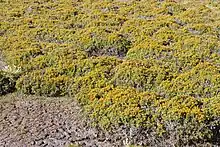Gleichenia alpina
Gleichenia alpina, commonly known as alpine coral-fern, is a small fern species that occurs in Tasmania and New Zealand.[2] It grows in alpine and subalpine areas with moist soils and is a part of the Gleichrniaceae family.[3]
| Gleichenia alpina | |
|---|---|
 | |
| Gleichenia alpina in Walls of Jerusalem National Park, Tasmania | |
| Scientific classification | |
| Kingdom: | Plantae |
| Clade: | Tracheophytes |
| Division: | Polypodiophyta |
| Class: | Polypodiopsida |
| Order: | Gleicheniales |
| Family: | Gleicheniaceae |
| Genus: | Gleichenia |
| Species: | G. alpina |
| Binomial name | |
| Gleichenia alpina | |
| Synonyms | |
| |
The species was first formally described by botanist Robert Brown in 1810.[4]
Description
Gleichenia alpina is a common native ground-fern that grows in boggy alpine and subalpine vegetation. It has the typical Gleichenia foliage, which is repeatedly dichotomously divided before ending in pinnate laminas. The distinctive feature is deep pouches densely covered with hairs on the underside of the pinnules.[5]
Gleichenia alpina is characterised by comparatively short frond axes and the dense orange-brown (becoming pale) scales that obscure the abaxial surface of the lamina. Its strongly pouched ultimate segments mean it can be confused only with G. dicarpa. From that species, G. alpina can be distinguished by: the absence of stellate scales with patent branches on the β costae; the strongly convex adaxial surface of the ultimate segments; only 0–1 (rarely 2) pseudodichotomous forks in the pinnae (excluding growth from pinna buds); the absence of accessory leaflets around the rachis bud; and pinna buds that usually extend, often more than once.
In contrast, G. dicarpa has: stellate scales with patent branches (curled in Chatham Islands’ plants) on the abaxial and/or adaxial surfaces of the β costae; complanate or weakly convex adaxial surface of the ultimate segments; 1–4 (rarely 0 or 5) pseudodichotomous forks in the pinnae (excluding growth from pinna buds); usually accessory leaflets around the rachis bud; and pinna buds that extend only occasionally and rarely more than once.[6]
Habitat
Gleichenia alpina occurs in subalpine bogs and scrub, and other cold, open habitats. It usually grows in the open, often growing through other vegetation, and rarely extends into forest. It favours wet ground, and is often found with Empodisma.[3]
Distribution

Tasmania: Found throughout Tasmania's alpine areas above 700m, some distributions include the Central Plateau, Walls of Jerusalem, Cradle Valley and Mt Field National Park.
New Zealand: North and South Islands. Exact distribution still unclear but plants matching G. alpina are known from the Central Volcanic Plateau, Takaka, and Denniston Plateau, and plants sharing the same haplotype as limited sampling of Tasmanian G. alpina are known from Mt Somers (Perrie et al. 2007). Currently the status of G. alpina in New Zealand requires further study as some reduced forms of G. dicarpa can be easily confused with it.[7]
References
- "Gleichenia alpina". Australian Plant Name Index (APNI), IBIS database. Centre for Plant Biodiversity Research, Australian Government, Canberra. Retrieved 9 May 2009.
- Gleichenia dicarpa. NZ Plant Conservation Network. Retrieved 15 January 2012.
- "Key to Tasmanian Dicots". www.utas.edu.au. Retrieved 16 March 2016.
- "Gleichenia alpina". Flora of Australia Online. Department of the Environment and Heritage, Australian Government.
- "Key to Tasmanian Dicots". www.utas.edu.au. Retrieved 2020-02-17.
- "Flora of New Zealand | Taxon Profile | Gleichenia alpina". www.nzflora.info. Retrieved 2020-02-17.
- "Gleichenia alpina | New Zealand Plant Conservation Network". nzpcn.org.nz. Retrieved 2020-03-21.